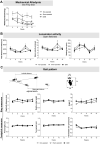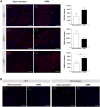Nociceptive mechanisms driving pain in a post-traumatic osteoarthritis mouse model
- PMID: 32943744
- PMCID: PMC7499425
- DOI: 10.1038/s41598-020-72227-9
Nociceptive mechanisms driving pain in a post-traumatic osteoarthritis mouse model
Abstract
In osteoarthritis (OA), pain is the dominant clinical symptom, yet the therapeutic approaches remain inadequate. The knowledge of the nociceptive mechanisms in OA, which will allow to develop effective therapies for OA pain, is of utmost need. In this study, we investigated the nociceptive mechanisms involved in post-traumatic OA pain, using the destabilization of the medial meniscus (DMM) mouse model. Our results revealed the development of peripheral pain sensitization, reflected by augmented mechanical allodynia. Along with the development of pain behaviour, we observed an increase in the expression of calcitonin gene-related peptide (CGRP) in both the sensory nerve fibers of the periosteum and the dorsal root ganglia. Interestingly, we also observed that other nociceptive mechanisms commonly described in non-traumatic OA phenotypes, such as infiltration of the synovium by immune cells, neuropathic mechanisms and also central sensitization were not present. Overall, our results suggest that CGRP in the sensory nervous system is underlying the peripheral sensitization observed after traumatic knee injury in the DMM model, highlighting the CGRP as a putative therapeutic target to treat pain in post-traumatic OA. Moreover, our findings suggest that the nociceptive mechanisms involved in driving pain in post-traumatic OA are considerably different from those in non-traumatic OA.
Conflict of interest statement
The authors declare no competing interests.
Figures





Similar articles
-
Alteration of sensory neurons and spinal response to an experimental osteoarthritis pain model.Arthritis Rheum. 2010 Oct;62(10):2995-3005. doi: 10.1002/art.27608. Arthritis Rheum. 2010. PMID: 20556813 Free PMC article.
-
Microarray analyses of the dorsal root ganglia support a role for innate neuro-immune pathways in persistent pain in experimental osteoarthritis.Osteoarthritis Cartilage. 2020 May;28(5):581-592. doi: 10.1016/j.joca.2020.01.008. Epub 2020 Jan 23. Osteoarthritis Cartilage. 2020. PMID: 31982564 Free PMC article.
-
Peripheral calcitonin gene-related peptide receptor activation and mechanical sensitization of the joint in rat models of osteoarthritis pain.Arthritis Rheumatol. 2014 Aug;66(8):2188-200. doi: 10.1002/art.38656. Arthritis Rheumatol. 2014. PMID: 24719311 Free PMC article.
-
Osteoarthritis pain.Best Pract Res Clin Rheumatol. 2015 Feb;29(1):90-7. doi: 10.1016/j.berh.2015.04.017. Epub 2015 May 16. Best Pract Res Clin Rheumatol. 2015. PMID: 26267003 Review.
-
Pain mechanisms in osteoarthritis: understanding the role of central pain and current approaches to its treatment.J Rheumatol. 2011 Aug;38(8):1546-51. doi: 10.3899/jrheum.100759. Epub 2011 Jun 1. J Rheumatol. 2011. PMID: 21632678 Review.
Cited by
-
Effects of a Combination of Polynucleotide and Hyaluronic Acid for Treating Osteoarthritis.Int J Mol Sci. 2024 Jan 30;25(3):1714. doi: 10.3390/ijms25031714. Int J Mol Sci. 2024. PMID: 38338992 Free PMC article.
-
Osteoarthritis Pain.Int J Mol Sci. 2022 Apr 22;23(9):4642. doi: 10.3390/ijms23094642. Int J Mol Sci. 2022. PMID: 35563035 Free PMC article. Review.
-
Prevalence, associated factors, and short-term impact of central sensitization in high-altitude patients undergoing total knee arthroplasty.Int Orthop. 2025 Aug;49(8):1887-1894. doi: 10.1007/s00264-025-06560-x. Epub 2025 Jun 7. Int Orthop. 2025. PMID: 40481833 Free PMC article.
-
Chondrocyte-specific knockout of Piezo1 and Piezo2 protects against post-traumatic osteoarthritis structural damage and pain in mice.Arthritis Res Ther. 2025 Jul 19;27(1):152. doi: 10.1186/s13075-025-03620-w. Arthritis Res Ther. 2025. PMID: 40684207 Free PMC article.
-
Selective block of sensory neuronal T-type/Cav3.2 activity mitigates neuropathic pain behavior in a rat model of osteoarthritis pain.Arthritis Res Ther. 2022 Jul 16;24(1):168. doi: 10.1186/s13075-022-02856-0. Arthritis Res Ther. 2022. PMID: 35842727 Free PMC article.
References
Publication types
MeSH terms
Substances
LinkOut - more resources
Full Text Sources
Medical
Research Materials

